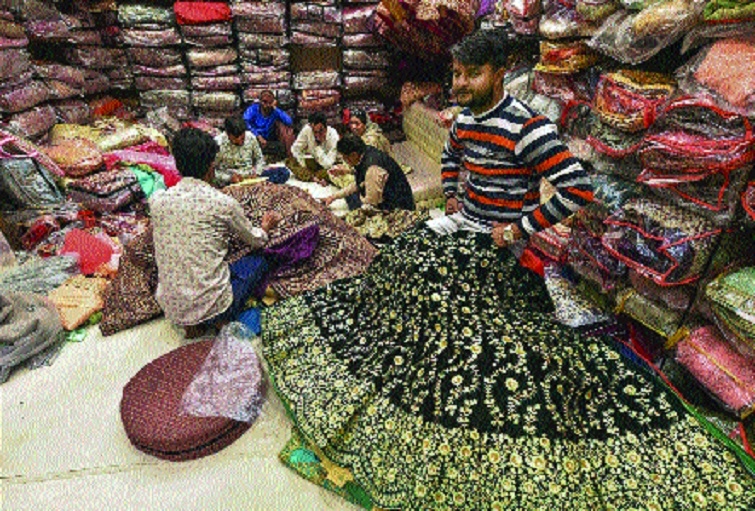Lehenga central At Chandni Chowk In Wedding Season
| Date :11-Dec-2019 |

By trisha mukherjee :
Nothing perhaps announces the wedding season in India - or indeed the latest in bridal trends - better than the crammed lanes of Chandni Chowk. As winter sets in over the capital, the preferred time to get married across the plains of north India, the packed streets of the historic Old Delhi market get a little more crowded with hundreds of brides-to-be from the city and beyond thronging shops to find the right lehenga for their big day. It could be silk, satin or even leather, designer rip-off or original, painstakingly embroidered by hand or machine, minimalistic or ornate, running into thousands and maybe several lakhs... If you want it, you get it in Chandni Chowk, the market where tradition and commerce go hand in hand. “While weddings in India take place round the year, the rush picks up around August and peaks about now,” said Vivek Kumar, a manager at a retail outlet selling lehengas created under the designer label of Aditya and Mohit. Most weddings in north India take place between October and March, when the hot summers give way to the cool of autumn and spring and the cold of the winter months.
Even with the ongoing redevelopment project in the area that has rendered the footpaths even narrower, Chandni Chowk is still evidently the place to be if you are wedding shopping. The market is known for its near accurate replicas of lehengas made by celebrity designers such as Sabyasachi Mukherji, Manish Malhotra and Falguni Shane Peacock, as well as those worn by actors in Bollywood films. The wedding trousseaus of both Delhi-based Bhavna Tuteja and Gurgaon-based Sonam Awasthi, for instance, were inspired from Sabyasachi outfits.Tuteja’s golden lehenga cost her Rs 80,000, a fraction of what an original Sabyasachi is priced at. “You get a lot of variety and the prices compared to places like Shahpur Jat or South Extension are reasonable.
Designer lehengas cost lakhs, but not everybody can afford that,” the 31-year-old said. Her lehenga, which she picked out after trying out at least 20 outfits, came with an intricately embroidered skirt, paired with a heavily embellished blouse and a net dupatta. Awasthi went for a traditional red lehenga, with golden floral motifs, also a Sabyasachi rip-off. “Chandni Chowk is special because you get many options in your budget,” she said. There are ‘Chandni Chowk originals’ too.
A two kilometre walk from gate 3 of the Chandni Chowk metro station leads to the unmissable three-storey Dalmia Fashions by Aditya and Mohit that stands just around the corner from the traffic intersection. One might have to push through crowds to reach the shop, but once inside it’s as chic and contemporary as an upscale designer studio in south Delhi. There are rows of bridal lehengas on display in colours both traditional, think shades of reds, golden and fuschia, and offbeat, such as ice-blue, champagne, pistachio, dusky peach and lilac. Kumar said they have lehengas that start at Rs 90,000 and go as high as Rs 5 lakh, all hand embroidered and created under the designer label of Aditya and Mohit. The lehengas are all custom-made and orders need to be placed at least two months in advance. Across the street is Gautam Chhabra’s CTC group that has been in the business since 1963. More traditional in its set-up as well as its collection, the shop has mattresses spread across the floor on which lay piles of lehengas as multiple shopkeepers show outfit after outfit for customers to make their pick.
Floor manager Manju explained that bridal lehengas are either machine-made or handmade. It’s not very difficult to spot the difference. Machine-made lehengas which range from Rs 10,000-30,000, are recognisable in their dense symmetrical embroideries. Hand-embroidered ones, which cost upwards of Rs 30,000, are more elegant and unique in their design. It’s a labour intensive business. “For hand embroidered lehengas, a single kali (vertical panels put together to create the flare) needs 15-20 artisans,” Manju said. While the trade of selling designer replicas has been going on in Old Delhi for years now, the Indian fashion industry is unhappy about the “outright cheating”. “It is difficult to create and easy to replicate,” said Suni Sethi, president of the Fashion Design Council Of India.
“This is a grave problem. Unscrupulous sellers employ workers to blatantly copy a work of a designer, who has put in a lot of hard work in R&D, and creativity. “Nobody has the right to use the name of a brand that a designer has spent 20-30 years to create,” Sethi told. Sethi blamed not just the sellers engaging in this “business of fakes”, but also customers. “Customers, even those who can afford an original, choose a copy because of the mentality of saving a few bucks,” Sethi said. While the Chandni Chowk market is abuzz with wedding shoppers, it is not untouched by the economic slowdown. Sales have plummeted, and shops are compelled to bring down the prices. Jatin Arora, director of Sunehree, said sales had gone down by 30 per cent. “People who would have paid Rs 3 lakh for a lehenga have now capped their budgets at Rs 1.5 lakh,” said Kumar from Dalmia Fashions. But budget crunch is hardly an excuse for a bride to not have her big fat Indian wedding. So, get going because great designs are available only till stocks last.